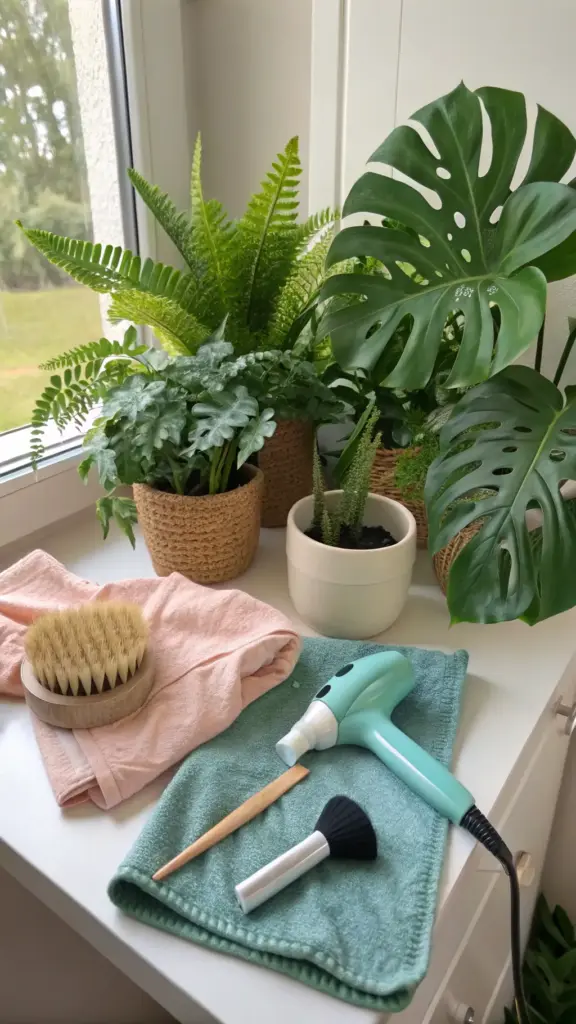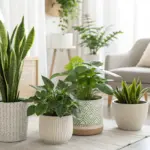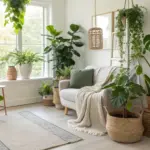5. Regular Maintenance Keeps the Illusion Alive

I thought I was so smart buying fake plants because they’d be “maintenance-free.” Six months later, my beautiful artificial monstera looked like it had been through a dust storm.
My mom walked in and immediately said, “When’s the last time you cleaned these plants?” Busted!
That’s when I realized regular maintenance is what separates convincing fake plants from obvious dust collectors.
Essential Cleaning for Different Materials
Here’s the thing – different artificial plant materials need totally different cleaning approaches, and I learned this the expensive way.
Silk plants get ruined if you spray them with water – I use a soft paintbrush to gently dust each leaf individually.
Plastic foliage can handle a damp microfiber cloth, but never use harsh chemicals that’ll make the colors fade.
For fabric leaves, I actually use my hair dryer on cool setting to blow dust out of all the crevices and folds.
My biggest mistake? Using Pledge on everything – it left a weird film that made my plants look obviously artificial.
Fluffing Techniques That Actually Work
Artificial plants get flat and lifeless if you don’t regularly reshape them, kind of like a bad haircut that needs styling.
I spend about 10 minutes every few weeks gently bending stems and adjusting leaf positions to create natural variation.
Rotating plants slightly each time I clean them prevents that “frozen in time” look that screams fake.
For trailing plants, I rearrange the vines so they drape differently – real plants grow and change, so yours should too.
Seasonal Updates Keep Things Fresh
This was a total revelation: changing your plant displays seasonally makes them feel alive and evolving.
In fall, I swap out some of my tropical fakes for artificial autumn foliage and add some seasonal elements like mini pumpkins.
Winter styling means moving plants away from heating vents (where real plants would struggle) and adding cozy elements.
Spring is perfect for introducing new “growth” – I’ll add a few new stems or smaller plants to existing arrangements.
Summer calls for more lush, tropical vibes – I bring out my biggest, most dramatic artificial plants during these months.
Smart Storage for Plant Rotation
I keep about 30% more fake plants than I display at any given time, stored properly for rotation.
Clear plastic bins with tight lids keep dust off stored plants, and I label everything so I remember what I have.
Tissue paper wrapping prevents delicate leaves from getting crushed during storage – learned this after ruining a $50 fake orchid.
I store seasonal plants in my basement, organized by season so I can easily swap things out.
Quick Fixes for Common Problems
Bent stems happen all the time – I use a hair dryer on low heat to warm plastic stems, then gently reshape them.
When leaves start falling off, a tiny drop of clear craft glue reattaches them invisibly.
Faded colors from sun exposure can sometimes be refreshed with fabric paint applied with a small sponge.
For droopy silk flowers, I learned that steam from my iron (held at a distance) can perk them right back up.
Dust buildup in hard-to-reach spots comes out easily with compressed air – the kind you use for keyboards.
I keep a plant maintenance kit with microfiber cloths, soft brushes, craft glue, and compressed air so I can tackle problems immediately.
Pet damage is real – my cat knocked over plants constantly until I started using heavier planters and museum putty to secure smaller ones.
Conclusion
These five styling secrets have completely transformed how I approach fake plant decor in my own home!
From mixing real and artificial plants to mastering imperfect placement, these tricks will help you create stunning green spaces without the stress of plant parenthood. Remember, the key is in the details – quality planters, strategic lighting, and regular maintenance make all the difference.
Ready to fool even the most discerning plant enthusiasts? Start with just one of these tricks and watch your space transform!
Which styling secret are you most excited to try first?









GIPHY App Key not set. Please check settings